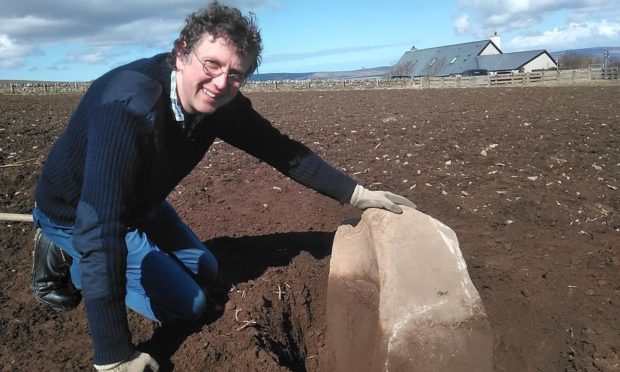The discovery of a huge prehistoric quernstone is the latest evidence of an Early Neolithic settlement on the outskirts of Kirkwall, Orkney.
Ploughing near Saverock, St Ola, uncovered the saddle quern, which was spotted by archaeologist Chris Gee, who has fieldwalked the site, after spring ploughing, since 2014.
The Orkney Research Centre for Archaeology project officer has been aided by volunteers and the University of the Highland and Islands Archaeology Institute students in the work.
Mr Gee has previously identified spreads of large building stones around a low mound in the field and recovered a wealth of Neolithic artefacts, including stone and flint tools, pottery, a stone bead and an arrowhead.
The style of the pottery and the arrowhead suggests an Early Neolithic date (c3600-3200BC) for the Saverock settlement, meaning it pre-dates Skara Brae by centuries.
Back on site last week, careful excavation revealed the sheer size of the quern.
Measuring 87cm long, 60cm wide and 46cm thick, it is estimated to weight over 200kg. Beneath it were more shards of Early Neolithic pottery.
It is hoped that charcoal found under the quernstone can be radiocarbon dated, allowing archaeologists to see where the Saverock site fits in with the three other known Early Neolithic settlements clustered around the lower slopes of Wideford Hill.
Previous discoveries
Between 1994 and 2013, the Cuween-Wideford Neolithic Landscape Project, led by Professor Colin Richards, identified and excavated four Neolithic settlements (Stonehall, Smerquoy, Crossiecrown and Wideford Hill) in the vicinity of Wideford Hill, and three others further afield (Varmedale, Muckquoy and the Knowes of Trotty).
During the project, excavation at the western base of Wideford Hill revealed the first evidence of Neolithic timber-built structures in Orkney.
Hopes of more discoveries
Mr Gee has thanked John Hamilton and Derek Shearer for their assistance in recovering the quern and the landowner, William Harcus, for allowing access to the field.
He explained: “The site wasn’t known about until a few years ago and when it was ploughed just a few weeks ago, the first thing I saw was the huge saddle quern which the plough had dislodged.
“As it is such a huge object it probably hasn’t moved too far and chances are it is quite near to a prehistoric house.
“I think there will be a couple of houses there 100s of years older than at Ska Brae.
“If this field is ploughed again in the future, we will have another look and possibly maybe see what structure remains in the future.”


